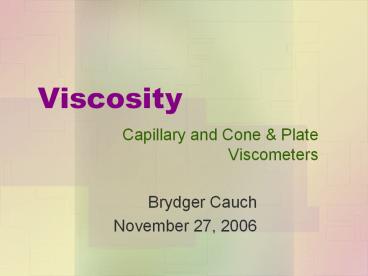Viscosity - PowerPoint PPT Presentation
Title:
Viscosity
Description:
Cannon-Fenske Routine Capillary Viscometer: Size 400 with T=25 C ... Cone and plate viscometer showed a larger deviation from the known viscosity ... – PowerPoint PPT presentation
Number of Views:6182
Avg rating:3.0/5.0
Title: Viscosity
1
Viscosity
- Capillary and Cone Plate Viscometers
Brydger Cauch November 27, 2006
2
Importance
- Classifies fluid flow
- Newtonian or non-Newtonian
- Motor Oil 5W30
- Higher NumberThicker
3
What is viscosity?
- Rheology
- Deformation and flow of matter under the
influence of applied stress - Viscosity, elasticity, and plasticity
- Viscosity
- Measure of the resistance to deformation of a
fluid under shear stress
4
Overview
- Theory
- Shear Stress
- Molecular Origins
- Newtonian and non-Newtonian fluids
- Operation of capillary and cone plate
viscometers - Calibrations
- Parameter for Capillary Viscometer
- Calibration Curve for Cone and Plate Viscometer
- Viscosity of an unknown fluid
- Conclusions
- Questions
5
Theory
6
Shear Stress Experiment
- Internal friction between layers of flow
(Wikipedia 2006)
7
Molecular Origins
- Gases
- Molecular diffusion between layers of flow
- Independent of pressure
- Increases with increasing temperature
- Newtonian
- Liquids
- Additional forces between molecules but exact
mechanics unknown - Independent of pressure except at very high
pressure - Decrease with increasing temperature
- Newtonian and non-Newtonian
8
Characterization of Fluids
- Newtonian Fluid
- Non-Newtonian Fluids are usually complex mixtures
(de Nevers 2005)
9
Operation of Capillary and Cone Plate
Viscometers
10
Capillary Viscometer
- Select appropriate capillary size to give
reasonable times - Keep constant temperature
- Time fluid falling between two fiducial marks (a)
and (b) - Avoid parallax
11
Brookfield Cone Plate Viscometer
- Shallow angled cone in very close proximity with
a flat plate - Important features
- Circulating bath to keep constant temperature
- Different cone sizes
- Level on the instrument
- Adjusting ring
- Motor speed in RPM
- Operation
- Adjust cup so pins barely not making contact
- Measure torque needed to overcome viscous
resistance
12
Calibrations
13
Calibration
- Capillary Viscometer
- Second term neglected for sufficiently long times
(gt60 sec) - Fluid of known viscosity used to determine
parameter B
14
Calibration
Cannon-Fenske Routine Capillary Viscometer Size
400 with T25C
Brookfield Standard Density (g/mL) Viscosity (cP _at_ 25C) Average time (sec) Parameter B (cPmL/gsec)
Fluid 100 0.974 0.005 (2) 96.6 89.84 0.22 (1) 1.104 0.006 (2)
Fluid 50 0.971 0.005 (2) 47.9 44.74 0.14 (1) 1.102 0.006 (2)
(1) Standard deviation (2) Propagated error
15
Calibration
- Brookfield cone and plate viscometer with cone
size CP-41 and T28.5C
16
Viscosity of an Unknown Fluid
17
Unknown Fluid
- Capillary Viscometer
- Accuracy 0.7 vs 0.2 reported
- Reproducibility 0.19 vs 0.1
Average Time (sec) Density (g/mL) Viscosity (cP)
89.890.17 (1) 0.9740.005 (2) 96.70.7 (2)
(1) Standard deviation (2) Propagated error
18
Unknown Fluid
- Brookfield Cone and Plate Viscometer
- Average viscosity95.51.5 cP (st dev)
- Accuracy 1.6 vs 1
Motor speed (RPM) Viscosity Reading (cP) Viscosity (cP)
6 85.8 94.5
12 86.0 96.6
19
Results
- Unknown fluid determined to be Brookfield Fluid
100 (µ96.6 cP) - Capillary Viscometer (25C)
- 96.70.7 cP
- Error of 0.10
- Cone and Plate Viscometer (28.5C)
- 95.51.5 cP
- Error of 1.1
- Students T Test
- 84.4 Probability they are the same
20
Conclusions
- Both viscometers straightforward once set up
- Capillary viscometer simpler and more accurate
- Cone and plate viscometer showed a larger
deviation from the known viscosity - Higher temperature creates error
- Lower viscosity at a higher temperature follows
the expected trend
21
Review
- Theory
- Operation of capillary and cone plate
viscometers - Calibrations
- Determining the viscosity of an unknown fluid
- Results
- Conclusions
22
References
- Viscosity. Wikipedia. 2006. 24 August 2006.
- lt http//en.wikipedia.org/wiki/Viscositygt
- de Nevers, Noel. Fluid Mechanics. McGraw-Hill,
New York, 2005. - Shoemaker, D.P., C.W. Garland, and J.W. Nibler.
Experiments in Physical Chemistry, 6th ed.
Mc-Graw-Hill, New York, 1996. - Measuring Viscosity with a Digital Viscometer.
21 June 2005. University of Utah. 24 August 2006. - lthttp//www.che.utah.edu/ring/Instrumental20Ana
lysis20CHE5503/SOP's/DigitalViscosity20SOP20Ver
201.222020206-21-05.PRC.docgt
23
Questions?

